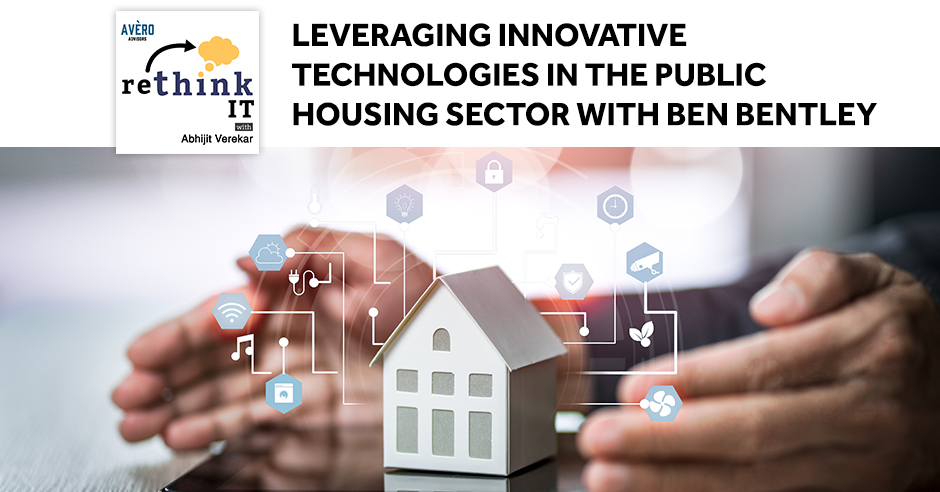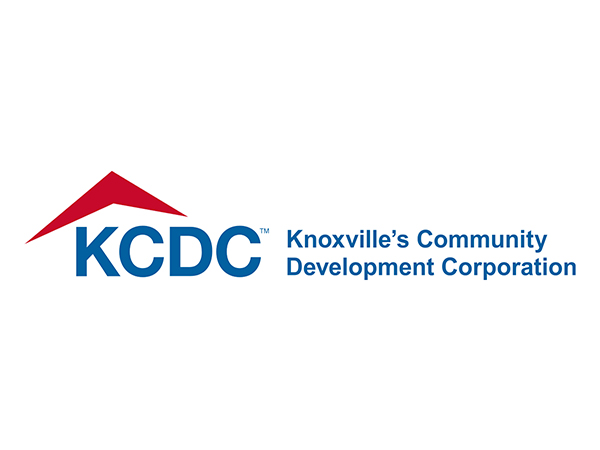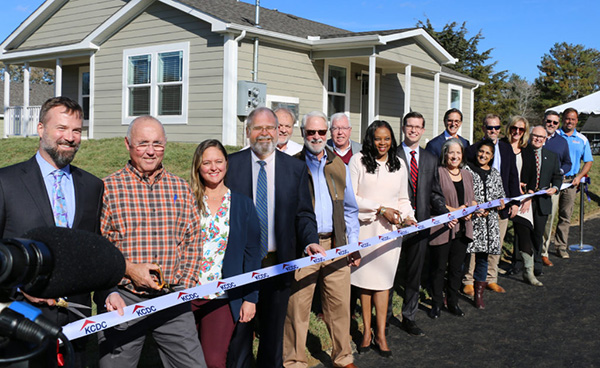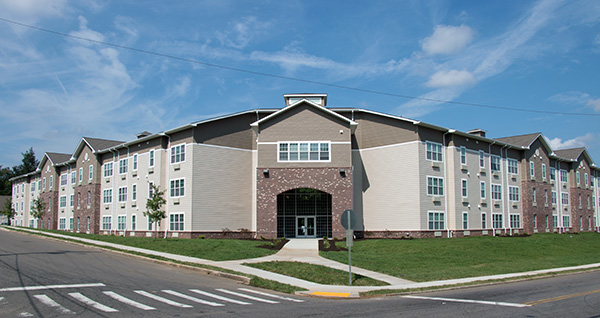Leveraging Innovative Technologies In The Public Housing Sector With Ben Bentley

The public housing sector is not just about providing livable spaces, but also ensuring a better quality of life for everybody. How are cities responding to this need with the help of information technology? Joining Abhijit Verekar to present the case of Knoxville, Tennessee, is Ben Bentley, the CEO and Executive Director of Knoxville’s Community Development Corporation (KCDC). Far from just being a helpful tool, Ben considers IT as a utility, something that everyone needs to thrive in this rapidly changing world. Learn how KCDC copes with the demands of their sector while working with limited funding and technological capacity.
—
Listen to the podcast here:
Leveraging Innovative Technologies In The Public Housing Sector With Ben Bentley
My guest is Ben Bentley from Knoxville’s Community Development Corporation, KCDC. Ben, welcome.
Thank you. It’s great to be here.
Ben, you and I were on the same 40 Under 40 class and you’ve been a client of mine. I enjoyed talking to you. What I wonder though, is how do you find yourself as the CEO of KCDC? What’s your personal story?
You never know what path you’re going to take when you begin a career. I knew as a pretty young child that I wanted to work in government and I wanted to do something that was impactful for people. If you had told me that I was going to get into the business of affordable housing, it would not have been anything I ever would have considered. I would have thought, “It’s more impactful for me to work on educational policy issues or something completely different. Work for the State Department and do international relations, diplomacy, or something like that.” Sometimes you end up on a path and for whatever reason, it ends up being the right place for you at the right time.
I started my career with HUD, at the federal level as part of the Presidential Management Fellowship Program. That was a great two-year introduction, number one, to what the federal government is like and number two, to what HUD is like. I got a real chance to meet with some high-level people at HUD. I get to understand the programs that they offer and the impacts that those programs have on individual’s lives not in Knox County, Tennessee, but across the whole country. Once I got my foot wet in the area of affordable housing and urban development, that was something that I figured out I liked and enjoyed.
I’ve bounced around a little bit. I lived in Nashville and Denver, Colorado for a little while, and Knoxville, Tennessee. In all of these stops, the common denominator is that there is a significant need for more affordable housing and also an additional investment in areas of education, workforce development, transportation, and health. A lot of these different issues around communities and neighborhoods where affordable housing exists. Those are some of the things that I’m passionate about and that we are working on here locally and I know other people who are working on in communities across the country.
We’re thrilled to have you in Knoxville, Ben. I enjoy every interaction we have. You and I’ve been talking about innovation, technology, and what that means to you and your agency. That’s the subject matter of this show. We could talk about everything all day, but tell me what the word ‘innovation’ means to you because it gets thrown around a lot.
Sometimes you find yourself on a path, and for whatever reason, it ends up being the right place for you at the right time. Share on XInnovation is continually trying to seek new solutions to old problems. In our business property management is the foundation of what we do and we have to be good at that. That’s not a new business, that’s been around for several centuries. There are new technologies that are enabling us to do that more effectively, whether that is operating the technological enterprise operating systems that we utilize to be able to do financial management, and also our leasing activities. Whether that’s more of a building information management system that allows us, and by the way, we’re dipping our foot into this.
There are other organizations and governments that have been doing this a long time, but they’ll allow you in real-time to get data back from some of your physical buildings to say, “Your building from an energy usage standpoint is underperforming what we would expect. What is the problem and how do we fix it?” With a pinpoint accuracy, those systems can help us identify problems in real-time and to solve them before they amount to extra tens of thousands on a utility bill or whatever the case might be. That was a long-winded way of saying that we’re trying to continually improve ourselves and work toward new solutions on things that we’ve been working on for many years.
Is there a difference in how those things work at the HUD level in a larger city like Nashville, Denver, and Knoxville? What have you found to be the difference in approaches through technology and different regions you worked in?
At the federal level, if you’re familiar with the Federal Appropriations Process, there’s a tendency to continue to fund programs that already exist. At HUD, there are all these existing programs. There’s a cost of living at an inflationary increase every year. The programs tend to get funded. Maybe at 100% maybe a little less, but there’s not an emphasis on making additional investments that are needed to improve the performance or efficiency of those programs. Technology a lot of times and systems at the federal level are 10 or 15 years old, extremely outdated, and inefficient. That’s because there’s not a will to reinvest in those systems and platforms that would make the programs work more effectively.
I would say there’s a big difference in terms of the timing and the momentum around technological innovation in big cities versus small cities. This is not always true. There are some small cities that are extremely sophisticated and some large cities that lag behind. From what I’ve seen, like any other trend in our society, larger cities tend to take the front role in terms of pushing innovation. I would say with technology and implementation, there’s a lot of lingo around smart cities, but all of those topics, they really do.
In Nashville and Denver, they’re a little bit ahead of what we typically see in Knoxville because there are more people working on these issues. Also, back to the funding thing. There tends to be more funding available to do things in larger cities. They push the envelope a little more in those areas, but Knoxville, for a city of our size and I don’t want to speak to the City of Knoxville because I am one small part of the housing piece. I think we’ve done a nice job in terms of implementing some things in the way of management of our infrastructure. Some things are small. I love the use of our parking system where they can monitor that in real-time and you can pay for it with a credit card, as opposed to me having to dig through my pocket for quarters. All those little things tend to add up to a better quality of life. They also make these systems that the government tends to operate a little more efficiently than they would otherwise be.
I know that the job involves staying on top of a lot of things and how fast technology’s moving. I find it difficult to keep up with things. What mechanisms do you have in place to stay on top of things and separate the riffraff from what might be useful to you?
That’s a challenging thing. We’re not a huge organization. We have about 130 employees all based in Knox County, Tennessee. For us, we have to rely on outside expertise. We have a wonderful IT department that has a staff of three. They can do a lot, but they can’t do everything no matter how great they are. We have to rely on outside consultants like yourself. For instance, our organization is going through the evaluation and selection of our enterprise software system, which is from an IT standpoint, probably the single largest decision that we’ll make over the next five years. We have to get it right.

IT In Public Housing: The common denominator among many communities is that there is a significant need for more affordable housing.
While we know from a property management and development standpoint, what are the things we need this system to do, it is hard for us to translate that from a technological standpoint into, “This is the system that’s going to operate best for us over a five-year period.” It’s going to fare well with all of the other, like the payroll and administrative functions of our agency. We have to rely on other people. I wish there was a better answer, like, “I have this magazine that tells me everything I need to know,” but that doesn’t exist. Tapping into the expertise of people that focus on IT is important for small and medium-size. I’m speaking from the government and all entity perspective but that’s true of business as well.
You have a lot of vision. In your role as a visionary, you think of things to make things better for your constituents and workers. Do you find it challenging to translate that vision to the IT workers saying, “I need something done, get it done?” Is there a translation difficulty there?
I would say for the most part, no. The biggest challenge from our organization standpoint and I’m sounding like a broken record, but we’re 98% funded by the federal government, by HUD and the funds to do something dramatic in the way of IT. Let’s say we want to retrofit our four large elderly high-rise buildings with all these sophisticated building information technologies. There’s no capital source of funds that we can effectively do that. We’re doing good to manage the backlog of capital needs that we have for elevators, flooring, sinks, and toilets.
That would be the biggest challenge. It is not so much letting IT staff understand what we need. It’s more about identifying the resources. I would say the second piece of that is identifying and trying to quantify what we’re going to get out of that investment over a 5 or 10-year period. If we’re going to make this investment, this $5 million in a building, what is the payback time? Just like any other capital investment, you have to understand that. That’s challenging. I know there are people out there that can help us with that.
That’s a great answer, Ben. You can’t always prioritize technology because you have many other things going on. We, in the tech industry, seem to think that’s number one priority always, but it’s not a grand reality. You mentioned buzzwords and smart cities. You’re not a city manager, but some of the same principles apply to your organization. Where do you think smart technology is headed in the public housing sector?
I will talk about an issue that’s hot not just from a public housing standpoint, but also nationwide. What we’re seeing with COVID and how that’s impacting individuals and families in a number of different ways. One of those is school begins to go back into session. It’s manifesting itself right now. The historic digital divide is being magnified. It’s been in existence for a long time, but people are taking note of it. Investment from a municipal perspective and the gaps that exist in telecommunications and internet accessibility particularly is extremely important.
The people that we serve in our sites, the low and moderate-income families are the people that tend to not have access to the internet at all or the access that they have is spotty or not affordable. Trying to fill some of those gaps, the challenges that infrastructure takes time to build it out. There’s not an overnight solution to that, but I feel like a transition moving toward the internet, other products, and some other telecommunications aspects as well as more of a utility. I view it as a utility, like water, sewer, and electrical that people need to thrive and succeed in life. That’s the biggest transition that I see. That’s beginning now but that’ll take 1 to 2 decades.
You mentioned utility. It absolutely is. You expect light bulbs to turn on when you flip the switch and Wi-Fi to be there and usable.
KCDC’s biggest challenge is not so much letting IT staff understand what it needs. It's more about identifying the resources. Share on XTo add to that, we, the people that have office jobs or a lot of people that are a little more affluent tend to take that for granted as if Wi-Fi is everywhere. Because maybe it happens to be everywhere that we go or most places that we go, but that’s not the case for everyone. One of the government’s roles is acknowledging that and if there is a gap and there’s a social need, which clearly there is, then filling that gap needs to be a priority.
I know that in our region, there are several efforts going on to try and solve their problem from KTech to KC, to the e-Knox Initiative. Hopefully, we can come up with something there. On an ongoing basis, the role of the CIO in a small or large agency has traditionally been the person that keeps the lights on and makes sure your desktop works. What are your thoughts on how that role has evolved or will evolve in the next couple of years?
You use the word ‘visionary.’ There are many true visionaries out there but that CIO role is going to have to be someone that not only has command of the technical, subject matter expertise, and whatever the needs of an organization are. They’re going to have to, more importantly, see how they can tie together what an organization or a business is doing with what’s coming on the horizon in the next 1, 2, and 5-year periods. Forward-looking, this is not a fair characterization, but someone that comes from a strict programming background or might be a hardware background and has a black and white regimented way of thinking is not going to make the best CIO in the coming years. You’re going to need somebody that is saying, “These are the trends that are here now but here’s more importantly, what’s coming down the pike.” How do we get out in front of this and make the right investments to improve efficiency, but more importantly, deliver whatever service we’re trying to deliver to the community?
More forward and strategic thinking and not just looking at what we already have.

IT In Public Housing: Telecommunications is transitioning to become more of a utility – something that people need to thrive and succeed in life.
A lot of large governments may already have it. It’s hard to find those people but there are many examples in the public sphere of people that already do that, but I think that trend will continue to progress.
Something to add there is the use of data. Big data is another term that we throw around a lot. What does that mean? It will be critical for the CIOs to understand the data your organization’s producing and make meaningful decisions or present them to your data sets and say, “We think this is the trend.” What do you think helps you make those critical decisions?
In most federal programs, we’re careful to make sure that the data that we receive is secure, but once you have a secure system in place, utilizing that data to make organizational decisions is critical. HUD, not only allows us but they required us to capture a lot of tenant-based data. If we can see trends and needs based on the data that we already collect, then it’s clear that’s going to help us move the organization in an area that will fill those things. Your point’s a great one.
Ben, what has been the biggest challenge you’ve taken on as the CEO or part of the leadership in the Public Housing Authority so far?
Historically, Public Housing, the program, it’s a specific federal program has been underfunded, particularly with capital funds. There’s a rule under public housing that we as an organization, even though we manage 3,500 units, could not borrow any money to make capital improvements on those units. Now, HUD has relaxed some of those rules. Over the past years, HUD has enabled Housing Authorities to be able to make those upgrades. That timeline happens to coincide to roughly when I’ve started working for the Housing Authority in Nashville and in Knoxville. Recapitalizing large housing portfolios that in many cases, the units were built anytime from the late ’30s to the ’40s, ’50s, and ’60s, and have not had a major recapitalization since those initial construction periods. There’s a lot of a backlog there and we’ve been working to fill that.

Over the years at KCDC, if you look at the replacement of units, new construction, and also rehabilitation in our 3,500-unit portfolio, we’ve invested over $100 million in those units. We’ve got a lot more that we want to do a lot more than we need to do. There’s such a backlog. This gets to, how do you quantify the benefit of technological investment relative to replacing a sink or a toilet? The things that are related to the basics of an apartment and a resident’s quality of life, you’ve got to do those things. There’s not a choice there, but then there are some more aesthetic decisions that you can start to make and making choices between aesthetics, maybe safety, and technology. All those things are related and how you measure them and how you decide ultimately is going to be a big part of what we do moving forward.
Hopefully, your tech upgrades will help you make those data-driven decisions in the near future. Ben, is there anything else you want to talk about or discuss? I’ve run through my list of topics.
I don’t know, at this point what value I can add to your reader here. My background is not technology, but everybody has to know a little bit about it or they’re going to fail. You’ve exhausted my knowledge.
You have more than you give yourself credit for. The show is supposed to be for people like you and me. I may pull it off, but I’m not a tech guy. I’ve got tech experts that work with me. I’m trying to get the conversation going around. It’s not scary. What you’re thinking is the right way of thinking. Let’s find a way to translate that to active products and services that we can make life better for everybody. Ben, thank you for coming on. I know you’re a busy guy, but I appreciate your time.
Thanks for having me.
